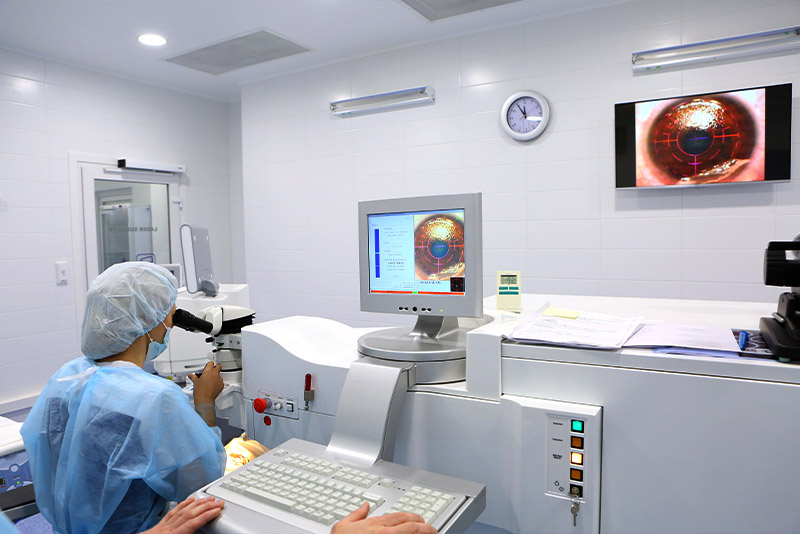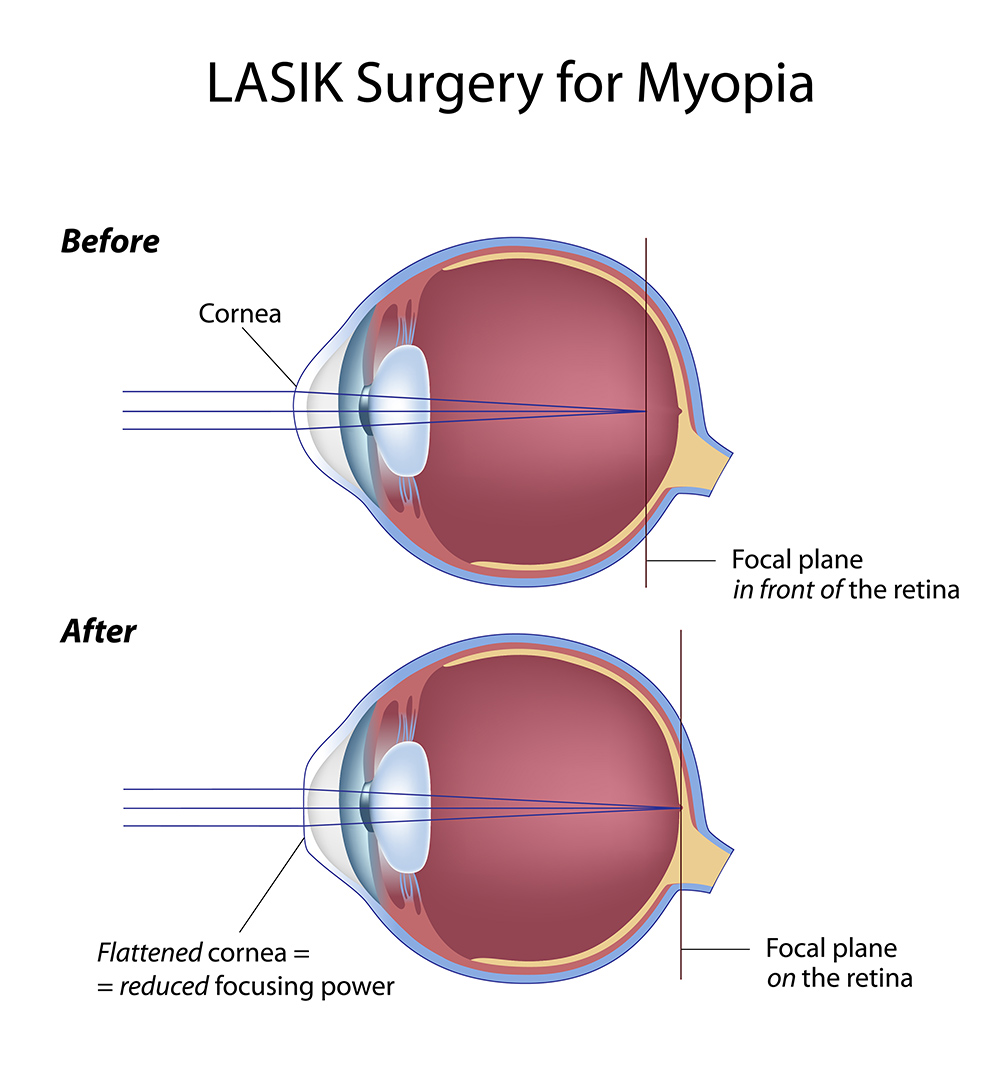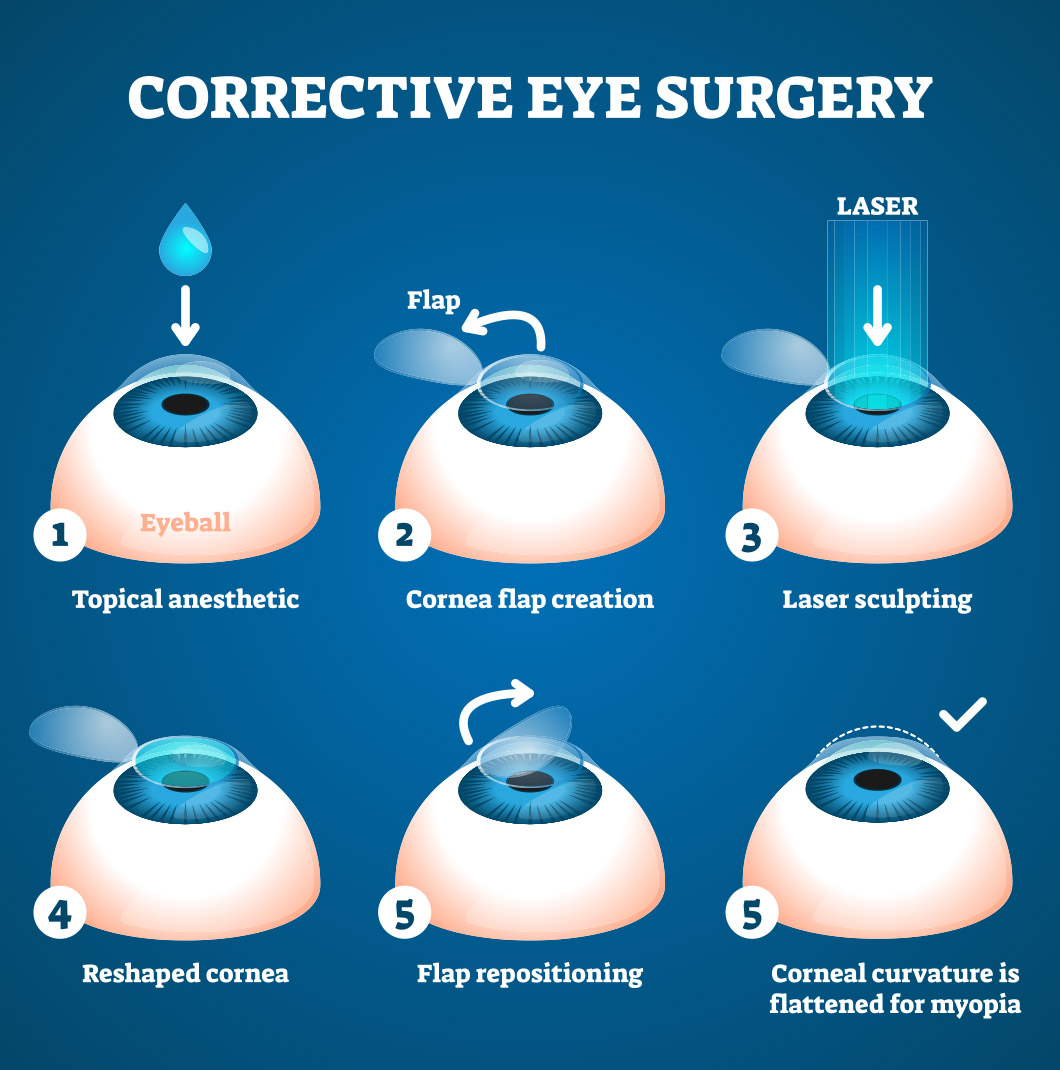
LASIK — Laser Eye Surgery
Considering Laser Refractive Surgery? Read on to learn more about the procedure, its alternatives, and whether you are a candidate
LASIK is a laser eye surgery that corrects vision
LASIK is a type of refractive surgery. This kind of surgery uses a laser to treat vision problems caused by refractive errors. You have a refractive error when your eye does not refract (bend) light properly.
For you to see clearly, light rays must travel through your cornea and lens. The cornea and lens refract the light so it lands on the retina. The retina turns light into signals that travel to your brain and become images. With refractive errors, the shape of your cornea or lens keeps light from bending properly. When light is not focused on the retina as it should be, your vision is blurry.
With LASIK, your ophthalmologist uses a laser to change the shape of your cornea. This laser eye surgery improves the way light rays are focused on the retina. LASIK is used to treat myopia (nearsightedness), hyperopia (farsightedness) and astigmatism.

The goal of LASIK is to correct your refractive error to improve your vision. LASIK eye surgery may reduce your need for eyeglasses or contact lenses. In some cases, it may even allow you to do without them completely.
Who is a good candidate for LASIK surgery?
To have LASIK surgery, you need to meet certain requirements. Here are some of them:
Some people are not candidates for LASIK. They include people with:
What to expect with LASIK
Before the laser eye surgery
You and your ophthalmologist will discuss your vision needs based on your lifestyle. For example, if you play sports, you may be seeking clear distance vision from surgery.
Also, you and your ophthalmologist should discuss your expectations for LASIK. People who have LASIK to achieve perfect vision without glasses or contacts run the risk of being disappointed. This laser eye surgery allows people to do most of their everyday tasks without corrective lenses. However, you might need to wear glasses for certain activities, such as reading or driving at night.
Your ophthalmologist will thoroughly examine your eyes and make sure you are a candidate for LASIK. Here is what he or she will do:
During LASIK
This laser eye surgery is done in an outpatient surgery center or your ophthalmologist’s office. Your eye surgeon uses a laser to reshape your cornea. Here is what to expect:

After Lasik
Vision after LASIK
About 9 out of 10 people (90%) who have LASIK end up with vision between 20/20 and 20/40—without glasses or contact lenses.
It is important to know that LASIK cannot correct presbyopia. This is the normal, age-related loss of close-up vision. With or without refractive surgery, almost everyone who has excellent distance vision will need reading glasses after around age 40.
To help with presbyopia, some people have LASIK to get monovision. This means one eye is left slightly nearsighted and the other eye is adjusted for distance vision. The brain learns to adapt so that the nearsighted eye is used for close work, while the other eye sees distant objects. Monovision is not for everyone. To see if you are able to adapt to this correction, you will probably want to try monovision with contact lenses first.
Like any surgery, LASIK carries risks of problems or complications you should consider. Some people have side effects after LASIK that usually go away over time. However, in rare cases, they may not go away. For example, almost everyone who has LASIK will have dry eyes and changing vision during the day. These symptoms usually fade within a month. For some people, though, they may take longer to disappear or they may remain.
Other side effects, either temporary or permanent, could include:
Other rare risks include:
Also, with LASIK, your vision may end up being under-corrected or over-corrected. These problems often can be improved with glasses, contact lenses, or additional laser surgery.
If you are happy wearing contacts or glasses, you may not want to have refractive surgery. Together, you and your ophthalmologist can weigh the risks and rewards of LASIK.
Wavefront-customized LASIK
Before surgery, the excimer laser is programmed with your wavefront data to prepare it to perform a very precise "sculpting" of each unique cornea. In conventional LASIK, this programming is based on your vision correction prescription (the same as used for your glasses or contacts.)
In wavefront-guided LASIK, computer imaging technology creates a very detailed three-dimensional "map" of your cornea that looks a bit like a miniature mountain range. This "map" is used to program the excimer laser for surgery. Wavefront technology can measure very subtle abnormalities in the surface of the cornea, enabling wavefront-guided LASIK to achieve vision correction beyond what is possible with glasses or conventional LASIK.
Also, wavefront LASIK has been shown in several studies to reduce side effects, such as problems with night vision and contrast sensitivity (the ability to clearly see objects against a background, such as black letters on a white page), and also to increase the percentage of patients who achieve 20/20 vision. Wavefront technology may also be used in PRK procedures, for similar reasons and with similar results.
How long does it take to heal after laser eye surgery?
One of the benefits of correcting refractive errors with laser surgery is that, in most cases, recovery is relatively quick.
Immediately after LASIK, or other similar procedures that create a replaceable flap in your cornea, your eye begins to heal. The day after your surgery, your eye surgeon or other eye doctor will test your vision and check to see that your eyes are healing as they should. In most cases, you can return to work, as well as drive, the day after the procedure.
If you have had PRK, healing may take a little longer. This is because a thin, outer layer of corneal cells is removed (rather than replaced as a flap like with LASIK or LASEK). The cells grow back, but it takes a few days after surgery to do so. This will delay the amount of time it takes to comfortably and safely get back to working and driving.
For several weeks or even months after laser eye surgery, it is normal to have some blurry vision or notice your vision changing. You may also have dry eyes, or see glare or halos around lights.
For six months or longer after laser surgery, you will probably be scheduled for regular follow-up visits with your eye doctor to check how your eyes are doing. In most cases, vision is stable and clear at about six months after surgery. If you had dry eyes or other visual disturbances after surgery, you should find most of these symptoms have disappeared or are much less obvious.
Past the six-month point after laser eye surgery, if you still have vision issues, your ophthalmologist may recommend another laser surgery procedure—called an enhancement—to fine tune your eyesight.
Refractive Lens Exchange (Clear Lens Extraction)
With refractive lens exchange (RLE) — also called Clear Lens Extraction or CLE — an artificial lens is used to replace your eye's natural lens in order to improve vision. The procedure is performed much like cataract surgery.
As is an option in cataract surgery, RLE may employ multifocal or accommodative intraocular lenses (IOLs). These lenses allow the ability to focus at all distances.
Some people who have early stage cataracts may choose to have RLE instead of waiting for their cataracts to progress to the point where they should be removed. This is because the lens implants generally provide them with better uncorrected vision at that point, particularly if they currently need vision correction.
RLE may also be an option for people with severe hyperopia (farsightedness), for whom LASIK is not recommended.
RLE is not FDA-approved, however, ophthalmologists legally may choose to perform this procedure in what is called an "off-label" use.
